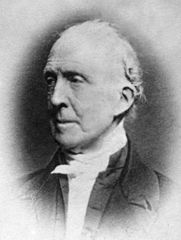Robert Whitehill (1738-1813) was a farmer and politician from central Pennsylvania. He was in the group of democrats who created the state’s
1776 constitution, which started with a Declaration of Rights.
When Pennsylvania held a convention to decide whether to ratify the new
U.S. Constitution of 1787, Whitehill opposed it, not wanting a stronger national government. He cited the lack of a Declaration or
Bill of Rights on the federal level as a reason to vote against the new document, reading a
petition from his home county specifying such rights. (He apparently wrote the petition.)
The Pennsylvanian convention’s delegates disagreed with Whitehill’s position, and some felt he was out of line suggesting such changes. The state approved the Constitution on 12 Dec 1787, delegates voting 46-23. Though that was a big majority, the votes in Delaware and New Jersey that same month were unanimous in favor of the new document, so that was the biggest opposition so far outside of
Rhode Island.
Whitehill and twenty of his colleagues then issued a minority report and dissent, putting that petition into print. By that time,
George Mason’s objections to the Constitution were already in print, and newspapers were publishing many essays about the issue.
The ratification process continued to roll through the U.S. until a close vote in the
Massachusetts ratifying convention: 187-168. That vote was the result of a compromise allowing the dissenters to specify amendments they wanted to see. The Massachusetts objections said little about individual rights and were therefore not based on Whitehill’s or Mason’s main arguments.
When
New Hampshire ratified the Constitution in June, nine of the thirteen states had assented to it. Under the rules the Constitutional Convention had stated and the
Continental Congress approved, that meant the document was officially accepted. However, it got a big boost when Virginia, the biggest state, approved later in June with its own list of recommended amendments.
At that point, Whitehill realized that the Constitution would take effect. But he, and other opponents, still wanted to see a Declaration of Rights. So Whitehill and other dissenters in Cumberland County, Pennsylvania, gathered at
James Bell’s tavern in what’s now Silver Spring Township.
They drafted this circular letter to like-minded men in other counties:
East Pennsborough, Cumberland, July 3, 1788.
SIR:
That ten states have already unexpectedly, without amending, ratified the constitution proposed for the government of these United States, cannot have escaped the notice of the friends of liberty. That the way is prepared for the full organization of the government, with all its foreseen and consequent dangers, is too evident, and unless prudent steps be taken to combine the friends to amendments in some plan in which they may confidently draw together, and exert their power in unison, the liberty of the American citizens must lie at the discretion of Congress, and most probably posterity become slaves to the officers of government.
The means adopted and proposed by a meeting of delegates from the townships of this county for preventing the alleged evils, and also the calamities of a civil war, are, as may be observed in perusing the proceedings of the said meeting herewith transmitted, to request such persons as shall be judged fit within the counties, respectively, to use their influence to obtain a meeting of delegates from each township, to take into consideration the necessity of amending the constitution of these United States, and for that purpose to nominate and appoint a number of delegates to represent the county in a general conference of the counties of this commonwealth, to be held at Harrisburg on the third day of September next, then and there to devise such amendments, and such mode of obtaining them, as in the wisdom of the delegates shall be judged most satisfactory and expedient.
A law will, no doubt, be soon enacted by the General Assembly for electing eight members to represent this state in the new Congress. It will, therefore, be expedient to have proper persons put in nomination by the delegates in conference, being the most likely method of directing the voices of the electors to the same object and of obtaining the desired end.
The society, of which you are chairman, is requested to call a meeting agreeable to the foregoing designs, and lay before the delegates the proceedings of this county, to the intent that the state may unite in casting off the yoke of slavery, and once more establish union and liberty.
By order of the meeting, I am with real esteem, sir,
Your most obedient servant,
BENJAMIN BLYTH, Chairman.
The letter didn’t mention a “Bill of Rights,” but that was the biggest change its authors wanted.
And that letter provides what significance in political history that partially demolished stone building beside the Harrisburg Pike has. It was where the men of Cumberland County called for a larger meeting of Pennsylvanians to organize a campaign for constitutional amendments and likeminded U.S. Congress candidates.
With Whitehill’s own estate gone (though noted with a
historical marker), I think we can definitely say that the James Bell Tavern is the most important site in the campaign for the U.S. Bill of Rights in Cumberland County, Pennsylvania. Whether it’s the most important such site in Pennsylvania as a whole is another question. And on a national scale it’s just one of many places where people advocated for changes to the U.S. Constitution. The push for what became our Bill of Rights was a mass political movement, not the product of any single man or event.
It’s sometimes said (by Pennsylvanian authors) that
James Madison drew on Whitehill’s writing when he proposed the Bill of Rights in the Congress in late 1789. However, his language came mostly from the Virginian convention, and it was influenced most by a fellow Virginian, George Mason.
TOMORROW: And what happened to that language, anyway?


.jpg/196px-Daguerreotype_of_Joseph_Story%2C_1844_(edit).jpg)



.jpg/289px-Samuel_Wale%2C_The_Bill_of_Rights_Ratified_at_the_Revolution_by_King_William%2C_and_Queen_Mary%2C_Previous_to_their_Coronation_(1783).jpg)







